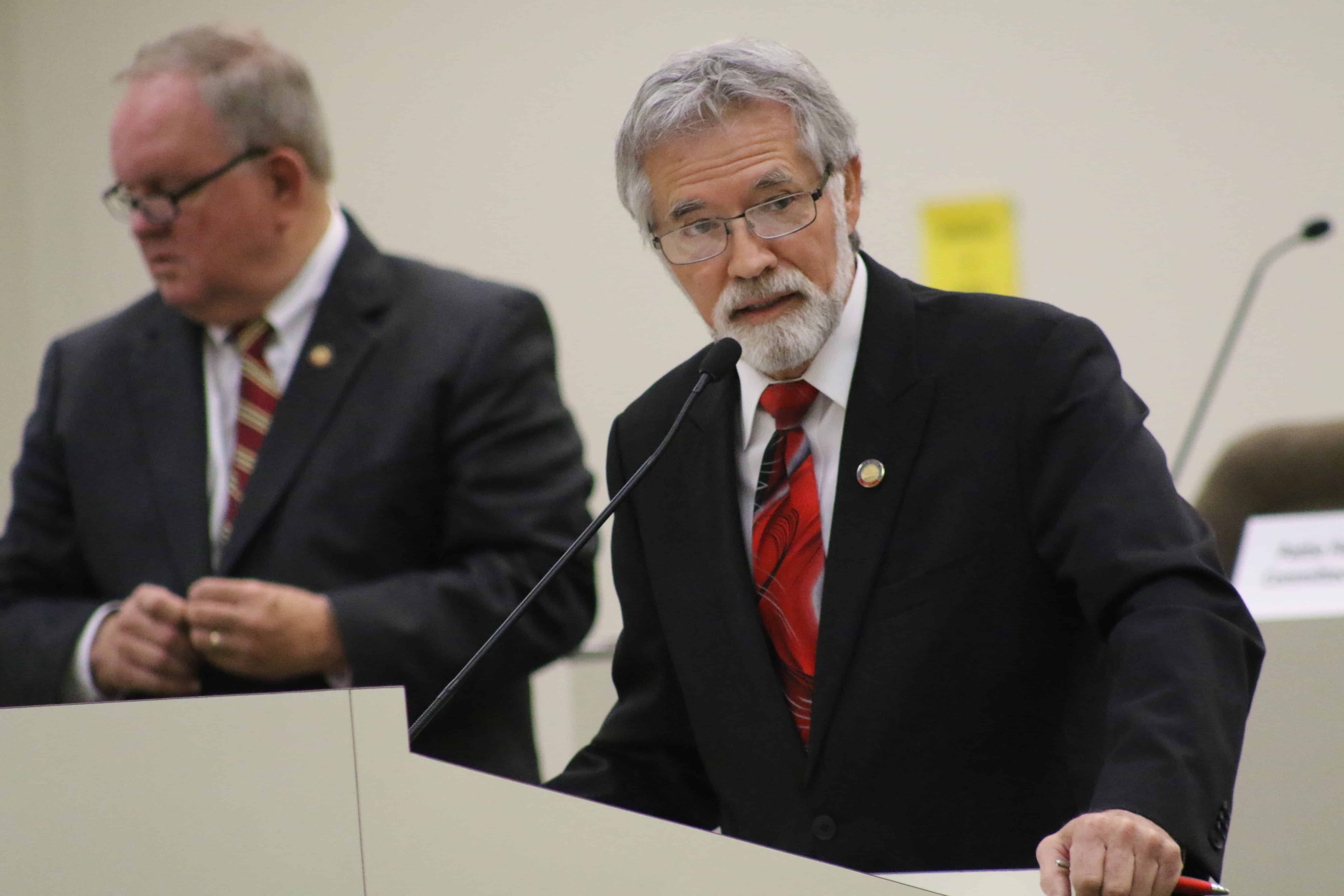The North Carolina House committee on K-12 education approved pieces of legislation Tuesday that would change how schools are graded, give school calendar flexibility to some counties, and require workforce opportunities for students statewide.
Abandoning the school performance formula
Amid a continued debate on the appropriate calculation of school performance grades, the committee gave a favorable report to House Bill 458 which would disregard blending student achievement and growth. Instead of the options previously proffered—80 percent achievement and 20 percent growth or a 50-50 formula— the measure would require all public schools to report two separate scores: one for school achievement and one for school growth.
Rep. Debra Conrad, R-Forsyth, said the bill, which she sponsored, is a way to maintain attention on third-grade proficiency while giving a growth score for an alternative look at a school’s quality. Conrad said she thinks the focus on achievement in recent years, especially in early grades, is important for children “to get the basics of the reading, the writing, the math, under their belts.”
“So I don’t want to take our eye off the ball of really knowing what the achievement level is at each school but this does give a separate grade for growth for those who want to focus on how a school is moving in the growth area,” she said.
Conrad said the bill was meant to lay out a “broad concept.”
“I know there’s a lot of detailed issues that we’ll have to work on over the next six months … but this just really takes it from the blend to the separate grade,” Conrad said.
There was little discussion on the change from a blended formula to two separate grades. Rep. Graig Meyer, D-Orange, said he thinks the split is a move in the right direction.
“I think it pushes us down the road on how we do school grading in some good ways,” Meyer said.
But committee members had questions about the bill’s details including how the state’s accountability system would align with the federal Every Student Succeeds Act (ESSA).
The State Board of Education has worked for months on a possible ESSA-compliant accountability system. It is not clear whether the A-F system will be changed to include the new federal requirements or if there will be a separate system under ESSA. Under this bill, the current system would be changed to be ESSA-compliant.
The bill lays out both the academic achievement indicators and the school quality and student success indicators in kindergarten through eighth grade, and for high school (see table below).
| Grades K-8 | Grades 9-12 | |
| Academic achievement indicators |
1. Student performance on annual math and reading assessments in third to eighth grade |
1. Algebra 1 or Integrated Math I End of Course (EOC) scores |
| School quality and student success indicators |
1. The rate at which students promote from third to fourth grade within four years of entering elementary school |
1. Biology EOC scores |
| English Learners Progress indicator | The percentage of students who achieve proficiency in English on annual tests in in the third to eighth grade | The percentage of students who progress in achieving proficiency in English |
| Graduation rate, based on percentage of students who graduate within four years |
Meyer said he worries these indicators overemphasize test results and do not take into account other options on how to measure school quality and student success.
“We’ve all tried to get away from making test scores the end-all-be-all of education,” Meyer said. “ESSA gave us more flexibility in thinking about other school success indicators, and this doesn’t really have a lot of creativity about what other school success indicators we might consider.”
When the State Board and former Superintendent of Public Instruction June Atkinson met with educators and administrators statewide last year, Atkinson said they found a common desire to go beyond test scores. How exactly to do that, she said, is hard to find.
Teacher of the Year Bobbie Cavnar created a service-learning project idea that aimed to incorporate a “whole child” approach and reflect schools’ individuality and creativity.
At the meeting Tuesday, Rep. Amos Quick, D-Guilford, said he does not agree with schools continuing to receive a low-performing status based on achievement instead of growth.
“A lot of those schools are having to overcome the debilitating affects of poverty,” Quick said. “And so for a school to meet growth or exceed growth and still have an opportunity to be identified as a low-performing school presents a challenge for me.”
Rep. Craig Horn, R-Union, said that ESSA regulations are still susceptible to change as a new federal administration and Secretary of Education take the reins.
“That thing could end up being about dogs and cats instead of schools with the way they’re going at the federal government,” Horn said.
The bill will be heard by the full House Wednesday.
Two paths to calendar flexibility
More than 50 bills have been filed by lawmakers in both the House and Senate so far this session on calendar flexibility. Many school districts want the authority to decide when they start and end the school year, while some counties are worried their tourism revenues would be significantly harmed.
A bill presented by Rep. Chuck McGrady, R-Henderson, and passed by the committee, would allow local school districts statewide to align their calendars with the schedule of the community college in their area. The synchronization is one reason why many schools want the flexibility. A school would not be able to open earlier than August 15 under the bill. McGrady said the provision is meant to appease some tourism businesses.
A separate bill the committee approved, presented by Rep. Harry Warren, R-Rowan, would create a three-year pilot program, giving calendar flexibility to 20 counties selected on the basis of student poverty levels, counties’ poverty tier designations, and the number of low-performing schools in the county, and other measures.
Warren said this is an opportunity to gather hard data on what counties should and should not have calendar flexibility.
“We’ve had calendar, what I call, rigidity, since about 2004 or 2005, but the purpose behind the bill is to show that this one size does not fit all, that we do have areas that can support calendar flexibility” Warren said. “We have studies that show that calendar flexibility has a positive impact on student performance, particularly in areas with a high-poverty population.”
The legislation would allow schools to start as early as August 10. Any county selected for the program could choose not to participate. The State Board would then have to pick a different county with similar demographics for the program. The following counties would be the initial selectees: Anson, Bladen, Cabarrus, Caldwell, Cherokee, Cleveland, Davidson, Duplin, Graham, Greene, Guilford, Martin, McDowell, Mitchell, Northampton, Robeson, Rowan, Warren, Washington, and Wilson.
Rep. Frank Iler, R-Brunswick, said his coastal county’s economy would be seriously hurt by calendar flexibility.
“I hope we’ll think long and hard before we put 19 counties much less 69 counties or 100 counties in a program like this,” Iler said. He said he estimates the state could lose about $5 billion dollars over 10 years if schools started earlier in August.
Warren said the Department of Public Instruction will be responsible for collecting data on the dates counties choose and the what effect, if any, the change has on student achievement. The Department of Commerce would assess the calendar changes’ impacts on the tourism industry. Annual reports from the two departments would be presented to UNC-Chapel Hill’s School of Government.
“What we’re trying to do is collect actual data,” Warren said. “In researching this, I’ve seen that a lot of the data that has been done in the past, studies that have been done in the past, seem slanted toward the tourism industry and are based on a lot of assumptions that are extrapolated out to come up with high-dollar impacts,” Warren said.
Warren said he thinks the study will be able to lay the foundation for making flexibility decisions in the future.
“I think it’s time that we get hard data to make a decision on,” he said. “We’re investing most of our budget in education. It’s incumbent on us to make sure that we do what we can to make sure that we’re getting the highest rate of return in student achievement and school productivity.”
The bill aligning school calendars with community colleges’ calendars now heads to the House floor to be heard on Wednesday. The bill creating the 20-county pilot program now heads to the House Committee on Commerce and Job Development.
An effort for more workforce development
The committee also gave a favorable report to the Future Ready Student Act, a bill that would require local school districts to create business advisory councils and offer at least two work-based learning opportunities.
Horn, who chairs the committee, is a primary sponsor of the bill. He emphasized the importance of closing the gaps in the state’s economy and preparing students for available jobs.
“We all are aware of the fact that we’ve got jobs waiting for people with skills,” Horn said. “We also are aware of the fact that not every student intends to pursue a baccalaureate degree or higher.”
The business advisory councils, Horn said, are meant to identify needs of the community, build career and technical education (CTE) partnerships with local businesses, and connect graduates with jobs. The bill also creates a competitive grant program for schools to apply for funds to hire additional staff to train students who wish to learn trades or workforce certifications.
The bill would also expand CTE programs to fifth grade, which typically start at sixth grade. Meyer said he is worried schools do not have certified CTE teachers or space in the fifth grade curriculum. Horn said the fifth grade program will be focus more on awareness, and that the grant program is intended to help with personnel needs.
“The essence of this Future Ready Student Act is to begin to expose these kids at an earlier age to opportunities that will produce jobs, and jobs that are desperately needed across the state,” Horn said.
The bill now heads to the House education committee on community colleges.



